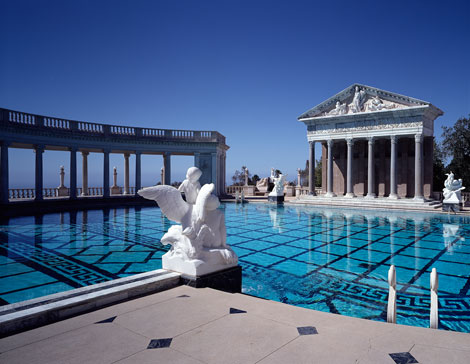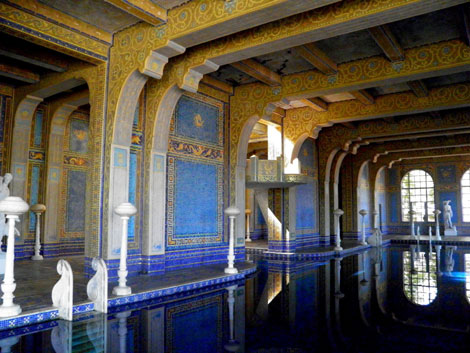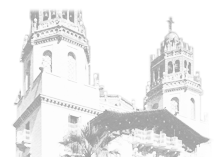Neptune Pool

Construction for the first of two Hearst Castle pools, the Neptune Pool, spanned 1924-1936. Three swimming pools were built on this site, each successively larger. Initial plans for the site called for a “Temple Garden” with an ornamental pool and temple structure. On March 31, 1924, W.R. Hearst wrote in a letter to Julia Morgan, “I am sending back the plan of the temple garden with the suggestion that we make the pool longer than it is, as long as a swimming pool. Mrs. Hearst and the children are extremely anxious to have a swimming pool!” On June 17, 1924, Morgan wrote that the first swimming pool was nearing completion: “Mr. Neptune and the two ladies can be placed but the finished basins will take some time yet.”
The second version of the pool, a substantial enlargement, was created in 1926-1927. This version had a series of concrete steps at the southern side called the Cascade, down which water flowed. The sculptures of Neptune and two nereids, now installed in the pediment of the temple, then stood at the top of the Cascade. The dressing rooms were begun in 1928 and furnished according to Hearst’s instruction.
The present version of the pool was under construction from 1934-1936. It is unlikely that the enlargement was done to make it closer to Olympic size, as has sometimes been conjectured; Olympic pools are 165 feet long. It is more likely that the colonnades and Cassou statues, which were planned from the late 1920′s, required an enlarged treatment. Morgan anticipated further modifications of the pool for Cassou’s Neptune statuary group to be placed in the small upper pool. On July 27, 1936, Morgan wrote in a letter to Charles Cassou, “enclosed is a plan and some photographs of the ‘Neptune Pool’ in its present (uncompleted) state. The recess of the main pool and the small pool above to receive your ‘Neptune’ group I have not touched since my visit with you last year – so please do not think of them except as something yet to be done to form a proper background and setting for your ‘Venus’ as well as your ‘Neptune’ statuary.” The “Neptune” sculpture group by Cassou intended for the small upper pool was never installed.
The final version of the pool as it stands at the Castle today is 104 feet long, 58 feet wide and 95 feet wide at the alcove. It is 3.5 feet deep at the west end, 10 feet at the drains, and holds 345,000 gallons of water. Other notable aspects of the Neptune Pool include the oil-burning heating system, the Vermont marble that lines the basin, gutters, and alcove, and four Italian relief sculptures on the sides of the colonnades.
Roman Pool
 The Roman Pool at Hearst Castle is a tiled indoor pool decorated with eight statues of Roman gods, goddesses and heroes. The pool appears to be styled after an ancient Roman bath such as the Baths of Caracalla in Rome c. 211-17 CE. The mosaic tiled patterns were inspired by mosaics found in the 5th Century Mausoleum of Galla Placidia in Ravenna, Italy. They are also representative of traditional marine monster themes that can be found in ancient Roman baths. The statues are rough copies of ancient Greek and Roman statues. One such copy represents the “Apoxyomenos.” Statuary was used on a considerable scale in the Baths of Caracalla.
The Roman Pool at Hearst Castle is a tiled indoor pool decorated with eight statues of Roman gods, goddesses and heroes. The pool appears to be styled after an ancient Roman bath such as the Baths of Caracalla in Rome c. 211-17 CE. The mosaic tiled patterns were inspired by mosaics found in the 5th Century Mausoleum of Galla Placidia in Ravenna, Italy. They are also representative of traditional marine monster themes that can be found in ancient Roman baths. The statues are rough copies of ancient Greek and Roman statues. One such copy represents the “Apoxyomenos.” Statuary was used on a considerable scale in the Baths of Caracalla.
The pool and surrounding room, which were built from 1927-1934, can be compared to an ancient Roman bath. The pool, like the baths, is located indoors. Its water was heated as in a tepidarium. However, in Hearst’s complex there were no hot or cold baths as there were in the ancient complex. The Roman Pool complex was designed to contain an exercise room, sweat baths, a handball court and dressing rooms.
The Roman Pool is decorated from ceiling to floor with 1″ square mosaic tiles. These glass tiles, called smalti, are either colored (mainly blue or orange) or are clear with fused gold inside. The intense colors and shimmering gold of the tiles combine to create a breathtaking effect. The designs created by the tiles were developed by muralist Camille Solon. The inspiration for some of these designs came from the 5th Century Mausoleum of Galla Placidia.
Hearst was affected by the beauty of the mosaics in the mausoleum and incorporated similar styles into his Roman Pool. The walls of the mausoleum are marble but the vaulted arches are composed of blue and gold smalti. The roofs and dome are covered with mosaics of night blue, powdered with stars. The Roman Pool is similar to the mausoleum with its blue and gold color scheme and stylized star patterns. It differs because marble was only used in the statues, not on the walls, and there are no religious murals.
Decorating the Roman Pool are eight marble statues. These statues were carved starting in 1930 by Carlo Freter working in Pietrasanta, Italy. They are rough copies of ancient Greek and Roman statues. The statue of “Apoxyomenos” is found near the east side of the building. “Apoxyomenos,” also known as “The Scraper,” is a statue of an athlete scraping dirt and moisture off the underside of his right arm. The original bronze statue was created by the Greek sculptor Lysippos c. 320 B.C.E. Because Lysippos’ work does not survive, Freter worked from an ancient Roman copy of “The Scraper” found in the Vatican museum in Rome. Freter faithfully copied the Roman copy but also completes the statue with the addition of the missing strigil (scraper) and the missing fingers of the outstretched hand.


